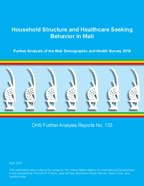There is no printed copy available to order.
Abstract:
This paper is one of the Further Analysis
Reports that use data from the Demographic
and Health Surveys conducted in Mali. This
report is based exclusively on the 2018
survey. The research question is whether
healthcare seeking, by women age 15-49 and on
behalf of children age 0-4, varies according
to aspects of household structure.
Three indicators of healthcare seeking
behaviour are used for women and three for
children. The indicators for women include
whether (1) the woman has had an HIV test;
(2) she had four or more antenatal care
visits for her most recent birth, and (3) her
most recent birth was in a facility. The
indicators for children include whether (1)
the child received postnatal care, (2) the
child was taken for treatment if the child
had diarrhoea in the past 2 weeks, and (3)
the child was taken for treatment if the
child had a fever in the past 2 weeks.
Several indicators of household structure are
included. The first is a simple distinction
between nuclear and extended households. By
definition, a nuclear household consists
solely of persons who are classified as the
head, spouse of head, or child of head. A
household that includes any de jure members
with a different relationship to the head is
an extended household. About one-third of
households in the 2018 survey are extended.
Such households are more common in urban
rather than rural areas. About 26% of
children in rural areas and about 47% of
children in urban areas live in an extended
household. For women, the percentages are 33%
and 54%.
Healthcare seeking tends to be greater in
extended households, for both women and
children. This effect appears to be due to
the presence of more adults in the extended
households, who are able to substitute for
one another with child care and other
responsibilities when a woman is temporarily
away from home for her own healthcare or that
of a child.
Three indicators of the household head are
included: sex, age (in broad categories), and
education. Since the proportion of adults
with secondary or more schooling is small in
Mali, the schooling indicator is simply if
the head has some schooling at any level, or
does not. The most pronounced effect is
related to this indicator. If the household
head has any schooling, healthcare seeking
tends to be greater than if the head has no
schooling. The age of the head is beneficial
for age 45 and over, compared to younger
ages. A male household head is beneficial for
most outcomes, but not for all.
The third indicator of household structure is
the relationship of the woman or child to the
head. For most outcomes, the beneficial
effect of an extended household extends to
all women and children, regardless of whether
they are the spouse or child of the head.
The report also examines the potential effect
of three standard indicators of women’s
empowerment—whether a woman makes decisions
alone (or together with her spouse) or lacks
the power to do so—for seeking healthcare,
making major purchases, or visiting friends
or relatives. The third has the strongest
evidence of a relationship, although in a
multivariate analysis with statistical
controls, none of the three is statistically
significant. These indicators were not
applied to healthcare seeking for children,
because we do not know specifically who in
the household takes a child for treatment for
diarrhoea or fever.
Perhaps the most striking findings in the
report are that the women and children in a
household are benefitted if the head has had
any schooling, even just primary; and that
healthcare seeking appears to be more likely
if the household is extended and includes
members who can substitute for a woman when
she temporarily leaves the household for her
own healthcare or for a sick child.
 Household Structure and Healthcare Seeking Behaviour in Mali (PDF, 2702K)
Household Structure and Healthcare Seeking Behaviour in Mali (PDF, 2702K)
